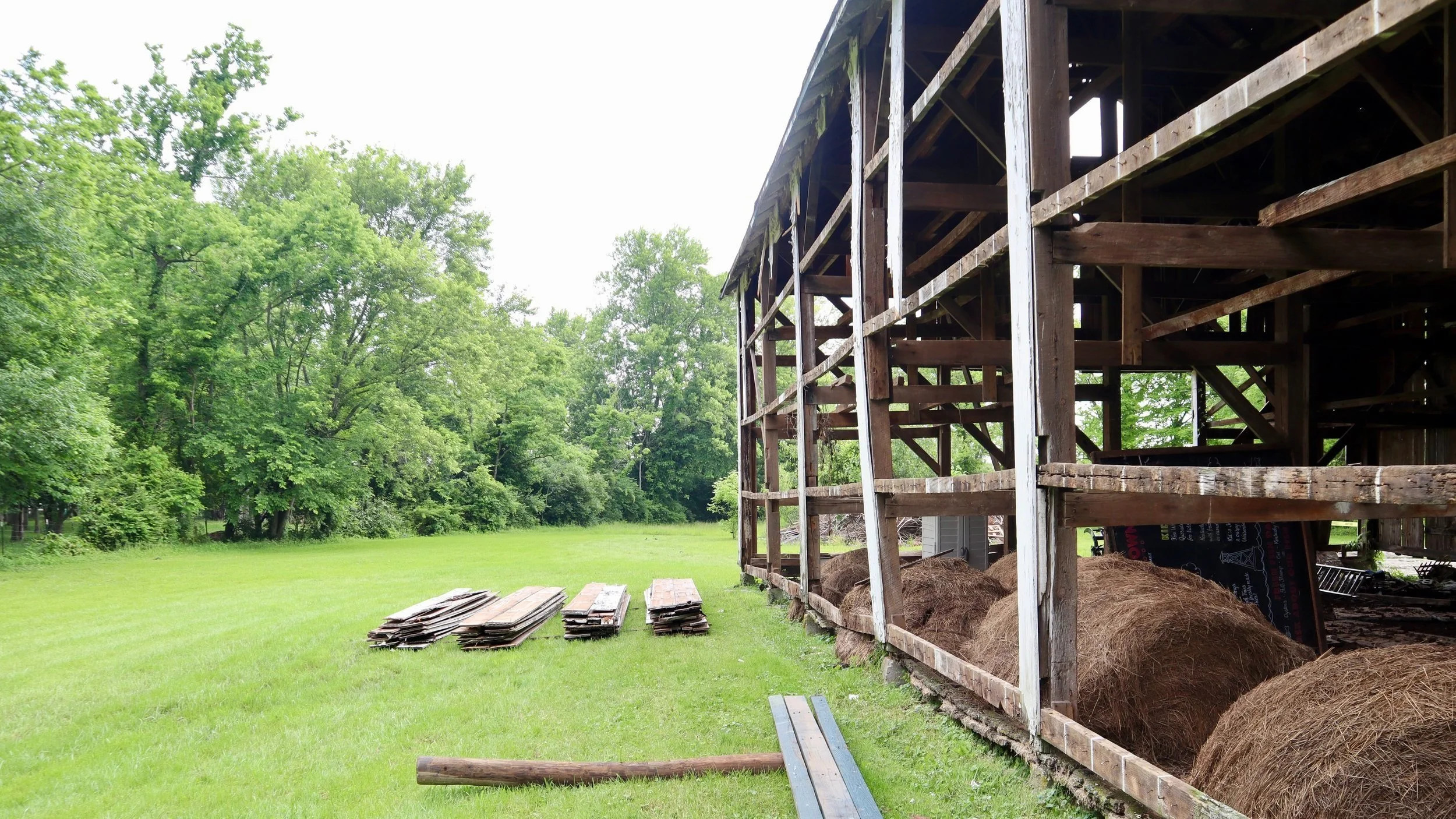Coming Down, Living On – A Barn Razing
story by Donna Hecker & photography by Talitha Schroeder
For a long time in Kentucky, seasons were measured by the cadence of the tobacco clock, and tobacco barns housed the promise of a farmer’s yearly income. As settlement money pushed burley aside in favor of more diversified crops, some barns were repurposed for livestock shelters, event venues, or farm markets. Others eventually fell where they stood; unable to resist the pull of gravity any longer, they simply folded in on themselves.
There’s a tobacco barn in the field behind Wallace Station; its weathered facade forms a backdrop for families enjoying lunch at the picnic tables scattered across the lawn. Over the years, it became a repository for detritus. Outdated menu boards, old table tops, and unidentifiable kitchen hardware joined stacks of discarded tobacco sticks, their usefulness outlived. A rusted tin thermometer advertising Chocolát Royale soda, once bottled by Barq’s in Cincinnati, is nailed to a timber.
But burley built the barn and its pungent odor still hangs heavy in the air; the moment you step into the sun-streaked interior, burley is what you breathe. Mike Frazier, who built out our cooking studio – and is now tasked with bringing down the barn – recalls skipping school as a teenager to hang tobacco on area farms.
The first time I got into a tobacco barn, I got kind of sick. I didn’t smoke so I’d never been exposed to nicotine. But I wasn’t afraid of heights, so I was usually in the top rail, hanging tobacco, until I got better at the operation.
We’re not sure exactly when our Wallace Station barn was built, but think it was moved here from elsewhere, maybe around 1930, which jives with other dates we know about. Wallace Station began life as a railroad depot in the late 1800s when the Versailles & Midway Railroad was chartered. Before that, the area was part of a large estate owned by descendants of Judge Caleb Wallace, who received it in a post-Revolutionary War land grant.
According to Owen Rouse’s excellent telling of Midway history, the Versailles & Midway Railroad was acquired by Louisville Southern in 1889, itself subsumed by the Southern Railway Company in 1894. A few years later, a narrow-gauge spur was put in to link a mill near Wallace Station to a phosphate mine on the south side of Old Frankfort Pike. It didn’t take long for the mine to be played out and by the 1930s, it was history and soon after so was Southern Railway.
Meanwhile, a country store in the same structure that houses present-day Wallace Station established a thriving business that lasted throughout the 1900s. And the tobacco barn was still in use at least into the 1980s, according to a local farmer whose own father rented it from the Craig family to house tobacco hauled from as far away as Owen County.
We hung tobacco by the truck lights a few times — me, my brother and others. Hard-working crew.
What’s going to happen to the barn now, we asked Mike. Will any of it be salvaged?
At first the plan was to just take it down. But now I’ve had time to hold that space for a few days and I’d like to reclaim more of the lumber instead of just throwing it in a landfill. I’ve been trying to figure it out, how to proceed.
Adaptive reuse is a trendy catchphrase now, but it pretty well captures what Mike and our staff farmer David Wagoner and others in our little company have been doing for a long time. Tobacco sticks support shelves in our cooking studio, our herb garden paths at Holly Hill Inn are paved with bricks rescued when a chimney took a tumble, tree stumps have been carved into toadstools.
So we’re confident that at least part of this old barn will continue to live on, and that all the timber Mike is able to save will be stacked and staged for its next supporting role. We wondered what that would be.
I don’t know. It’s always interesting to see how things take on new lives…how they have past lives and then end up with new ones. And the transition between the two. The options are endless at this point. But if we don’t save the old wood, if it goes to a landfill, then we know its life is over; the timber’s purpose ends there.
As we watch the old barn come down, and ponder the possibilities, there’s one thing we know for sure. It still has stories to tell.
Related Content
Wallace Station Then & Now
Chris and Ouita Michel opened Wallace Station on Old Frankfort Pike in the summer of 2003. Referred to on maps as US Hwy. 1681 and by oldtimers as Shady Lane, Old Frankfort Pike is a national scenic byway. It’s a beautiful drive any time of the year but especially in the spring and summer as ancient trees embrace in the center of the roadway to cast a canopy of shade.
© 2025, Holly Hill Inn/Ilex Summit, LLC and its affiliates, All Rights Reserved







